Novelist May Futrelle survived Titanic but told many conflicting stories about the disaster. What was really true?
Introduction
Throughout the decades, often owing to loss of memory or to incorrect impressions, a number of Titanic survivors recalled their experiences less than accurately. At times, it was an unaccountable desire to embellish their stories that survivors told untruths. Margaret Brown made up tales, exaggerated others; so did Robert Daniel, Arthur Peuchen, Charles Lightoller, René Harris, Lucy Duff Gordon, Edith Rosenbaum, Eva Hart, Violet Jessop and many others. But falsehoods were so shamelessly frequent on the part of one survivor that it’s difficult to discern the details of what exactly happened to her on board Titanic during its sinking.
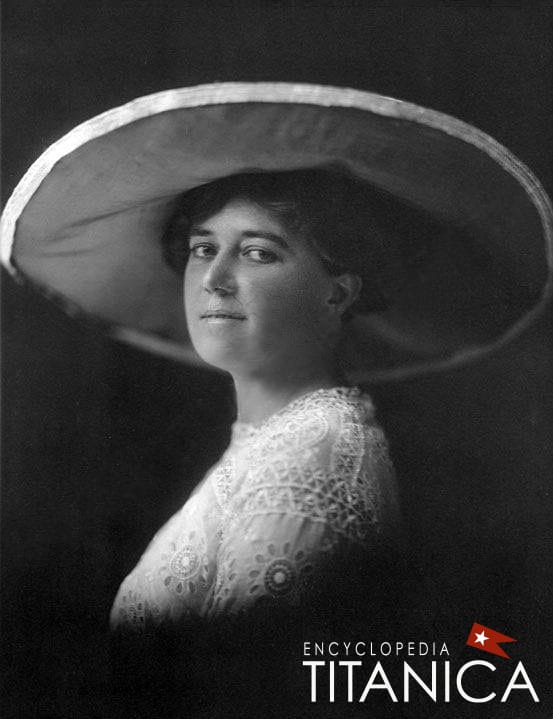
(Atlanta History Center)
According to accounts examined for this study, most published between 1912 and 1959, romantic fiction writer May Futrelle was either walking on deck when the ship hit the iceberg or she was reading in bed, she escaped in both a portside lifeboat and a starboard one, the band played Nearer, My God, to Thee or it didn’t, her lifeboat held 30 people or it carried 63, and finally, the ship either broke in half or it sank in one piece. All this was claimed by her at some point in interviews she gave or in articles she wrote over a span of more than 45 years.
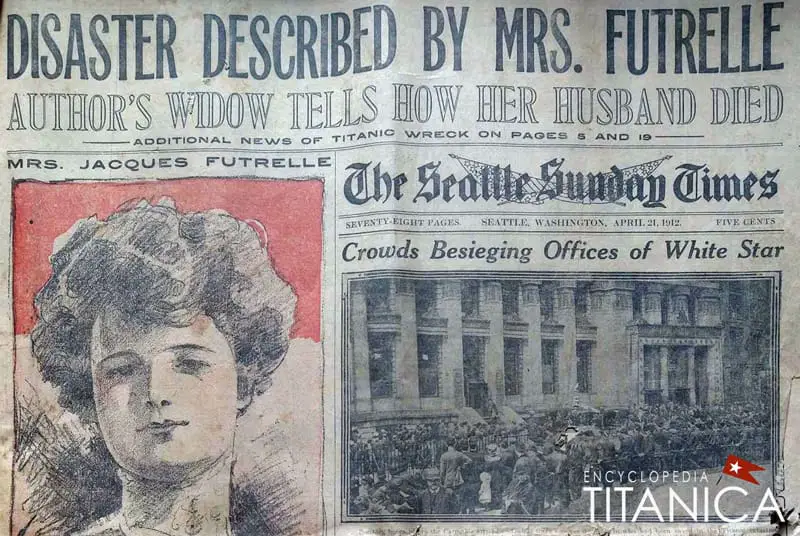
(Ioannis Georgiou)
The lady’s tendency to fabricate is so ridiculous that if she were not lying about a shipwreck that killed almost 1,500 people, including her husband, it would be comical. But as the point of this article is to tell her story, not criticize her, I’ve done my best to determine what May Futrelle went through by weighing her statements against a variety of more reliable sources. I have also tried to understand what level of shock or trauma she might have undergone that could have caused her tendency to embroider her experiences to such an extent.
May’s career as a journalist, essayist and novelist falls beyond the focus of this work, as does the even more prolific writings of her husband Jacques, nicknamed “Jack.”
I’ve tried to be as fair to May as I can be, although I can’t say after researching her that I admire her much. She appears to have had a cruel streak, believed men were omnipotent while women were “weak” and “useless.”1 She wasn’t witty, was anything but charming, seemed full of her own importance. Yet May was married to a popular author of the time, and was herself as arresting a writer as she was a complete bore in real life.
Surviving one the world’s most astonishing tragedies, May sanctioned many a tale to obscure the pain of losing her soulmate. Lying to forget, trying to erase a past that hurt, seemed her only way of coping. For that I have compassion, and I hope this work finally brings clarity to her erratic tales of that terrible night.
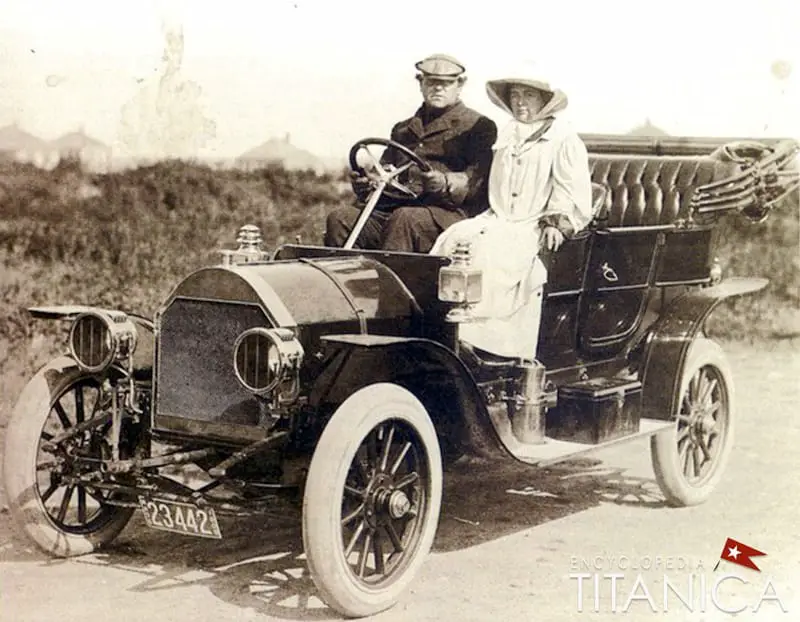
(Atlanta History Center)
Boarding Titanic
Jacques “Jack” Futrelle and his wife of 17 years, the former Lily May Peel, boarded Titanic from Southampton Harbour, England, on Wednesday, April 10th, 1912, having spent the night before at a hotel party in London for Jack’s 36th birthday. Neither had slept much but they managed to make the boat train to Southampton in time to catch the great Titanic. This brand-new leviathan of the seas would be sailing from there that day to New York on its maiden voyage, via ports in France and Ireland.
Jack was “36 on Tuesday and dead on Sunday,” May told the Boston Herald in 1955 just after Walter Lord’s A Night to Remember was published. “If my husband had got drunk that night, he might not have sailed and he might be alive today. But he never did drink much.”2

(Atlanta History Center)
The Futrelles were both from Georgia, but by 1912 they were living in Massachusetts with their two children — a daughter, Virginia, 14, and a son, Jacques, Jr., 12. The pair was looking forward to peace and relaxation following a hectic business trip to Europe that had concluded with Jack’s late night London birthday bash on April 9th. In England, he had signed contracts for future books and article serializations connected to his flourishing career as an author of detective stories, of which the most famous was The Thinking Machine. Some of Jack’s latest works had, however, been more like the romantic novel his 35-year-old wife, usually called May, had recently published (her first), Secretary of Frivolous Affairs; it had become a bestseller.
Famous though he was for his literary efforts, Jack wasn’t given a free ticket on Titanic because its owners, the White Star Line, wanted to “treat” him as May later claimed, the first of many untruths she spread — some out of faulty memory, others not as innocently spun.
As silly as her contention was, May was right that her husband’s celebrity was impressive. But as they would soon find, Jack was hardly alone as a noteworthy name on the First Class passenger list. Apart from millionaires like Col. John Jacob Astor IV, returning from a honeymoon with his now pregnant wife, Madeleine, there were scores of equally prominent men and women aboard. There was Isidor and Ida Straus (he a cofounder of Macy’s) who had spent the winter at San Moritz. There was mining magnate Benjamin Guggenheim, traveling discreetly with his girlfriend, Leontine (Ninette) Aubart. The railroad tycoon Charles Hays and his family were on board as was artist Frank Millet and journalist W. T. Stead, en route to a peace conference at Carnegie Hall.
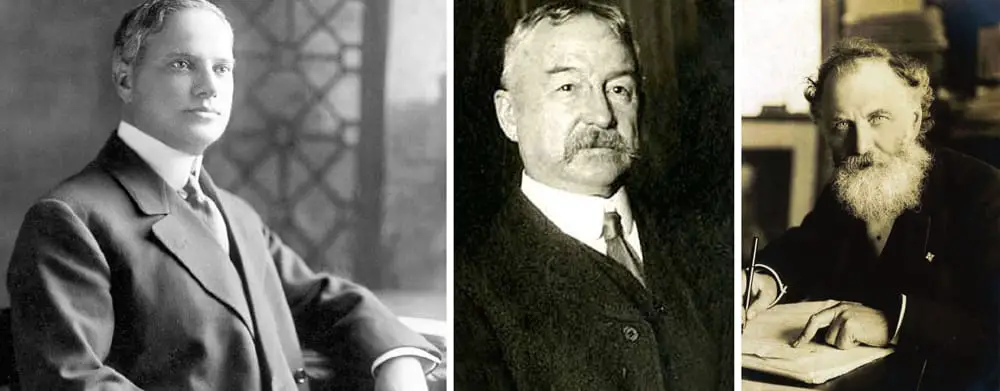
(Randy Bryan Bigham)
The London-based fashion designer Lucile, in private life Lady Duff Gordon, was on Titanic with her second husband, Olympic athlete Sir Cosmo Duff Gordon, and her secretary, Mabel Francatelli. Lady Duff Gordon’s photo appeared over fashion columns in weeklies across the United States so she was traveling incognito with her husband as “Mr. and Mrs. Morgan and Maid” to elude the press. The pseudonym is believed to have been the inside joke of one of her friends and investors, Anne Tracy Morgan, daughter of J. P Morgan, ultimate owner of the White Star Line.
Interior design guru Helen Churchill Candee was also a passenger. So was British socialite and philanthropist Noëlle, Countess of Rothes, joined by her husband’s cousin, Gladys Cherry. There was a White House bigwig in the person of Maj. Archie Butt, military aide to President Taft, and there were sports figures like tennis stars Dick Williams and Karl Behr. There was even a relatively new type of personality on Titanic, a beautiful film star who’d previously been a popular artist’s model, Dorothy Gibson, known as “The Harrison Fisher Girl.”
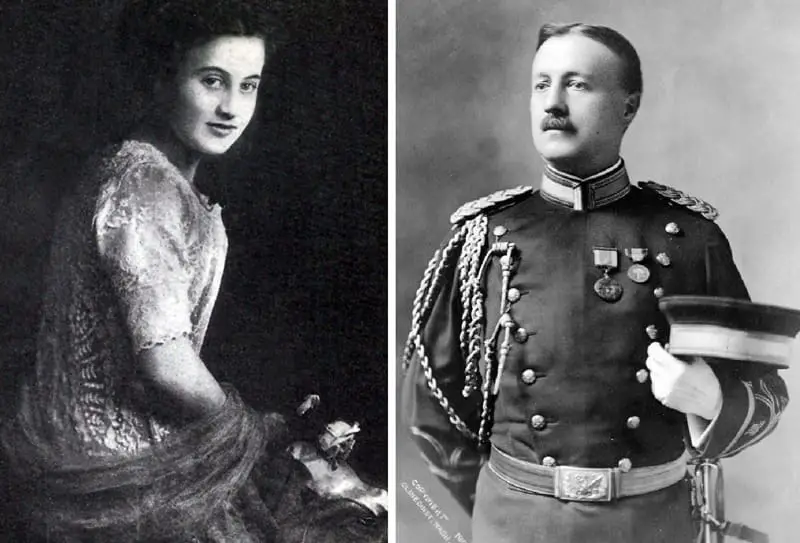
(Randy Bryan Bigham / Library of Congress)
The Futrelles soon rubbed shoulders with these and other elite passengers, not least of whom were one of the ship’s designers, Thomas Andrews, and the chairman of the White Star Line himself, J. Bruce Ismay.
But of their fellow famous voyagers, Jack and May came to know best the Broadway producer Henry B. “Harry” Harris, 45, and his wife, René, 35. Here we encounter another tall tale of May’s: the Harrises, fresh from their own European vacation, had not previously known the Futrelles as May alleged. The foursome met on Titanic. But they did become instant confidantes, especially after learning they occupied staterooms near one another on C Deck, just beyond the aft grand staircase foyer.
The couples met on deck at a propitious time — Titanic was just steaming out of Southampton Harbour a bit past noon when the force of the ship’s propellers churned up enough water to cause mooring ropes to break on a neighboring ship, the American Liner New York. Standing aft on the Promenade Deck, the Harrises and Futrelles witnessed the incident of the errant ship drifting toward Titanic by the suction of its engines and they made light of the close-call.
Although May’s memory of the joke that Jack made to Harry can’t itself be relied on, it does square with René’s memory of the episode. According to May, as they watched the ships almost collide, Jack quipped, “I’m a good swimmer, Harry. How about you?”3

(Wisconsin Historical Society)
Making / not making friends
May found the trip exhilarating:
Then came the prettiest voyage I ever experienced. The ocean all the way was like an inland lake. Crowds came on the pier at Cherbourg and at Queenstown. Even the peddlers, who crowded about the ship with laces, cheered us. The nights were so brilliant that you could see far ahead by starlight. We were very gay. No one was seasick, and we made a great occasion of the dinners. The women got out their new Parisian gowns, and the men all dressed. On the second day, Jacques and I went over the whole ship. I had heard from someone – I’ve forgotten who – that the Titanic had been put to sea unfinished. I noticed then that in the Parisian café men were fitting doors.4
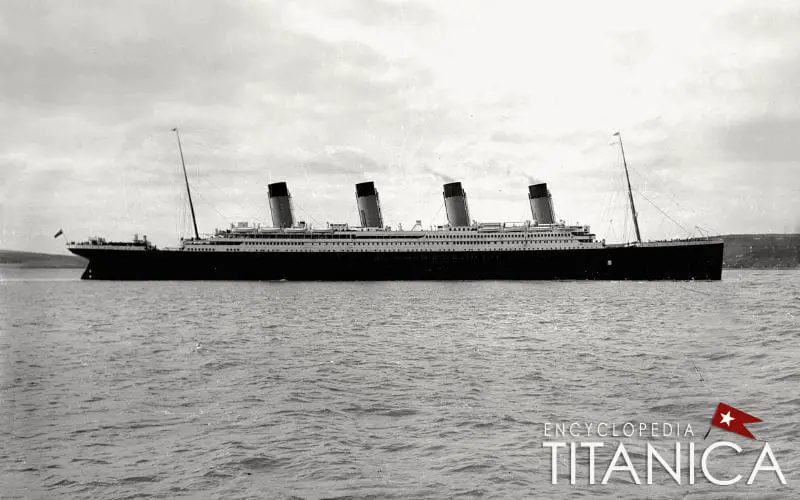
(Brandon Whited)
By Sunday, April 14, the Futrelles and their fellow travelers had settled into routines. Jack and May promenaded about the deck with the Harrises and on some of their walks they encountered the Astors, the most famous couple aboard:
Someone had pointed out the Astors to us. Of course I, with every woman on the boat, was curious about them. His height and her smart little figure would have made them noticeable in any circumstance. She was wearing a pretty ermine cap and we used to spot it all over the ship for they moved about among us very freely. They were all alone most of the time. Perhaps they would have been rather glad to scrape up a few acquaintances. I used to think so when I saw her glance up from her reading at everyone who passed. But of course the rest of us felt that it would have been rather presumptuous to make the first move.5

(Randy Bryan Bigham)
In the evening, Jack and May were ready for dinner and they made plans to eat in the à la carte French restaurant on B Deck, accompanied by Harry and René Harris. As May recalled:
Sunday night came. We had started on the last leg of our trip; we were almost home and eager to see home sights and faces, as people are at the end of a foreign trip.6
The Harrises were booked in C-83 near the foot of the aft grand stairs. The Futrelles are believed to have been across the hall slightly further aft in C-123, although no definite assignment exists for Jack and May. Just before dressing for dinner, René fell down the stairs as she descended to her room to change. She broke her right arm at the elbow, plummeting down about seven steps. She claimed to have slipped on a spot of grease left by a fallen teacake.
Despite the accident, René kept her date for dinner with the others and appeared in the restaurant in a sleeveless evening dress, her arm in a sling. Various diners, including other famous people, greeted her. One was Captain Edward J. Smith. René reminisced:
When I entered the ‘Ritz Room,’ I had a reception from the diners, most of whom I had not met. It made me think a broken arm was an asset. I had just sat down at our table when Captain Smith came into the room. I had not before met the captain. In passing our table, he stopped and congratulated me on my spirit.7

(Encyclopedia-Titanica / Gregg Jasper)
They were also greeted by Sir Cosmo and Lucy, Lady Duff Gordon, seated with the designer’s secretary at a nearby table. The meeting was René’s first, but Harry already knew ‘Mme. Lucile,’ as she was called in the British media. At the moment, Lucy was designing costumes for Harry’s latest hit play in New York, The Quaker Girl, starring Ina Claire. Although not impossible, it’s unlikely the Duff Gordons knew the Futrelles and were therefore meeting them for the first time, too. If so, Lucy’s not recognizing May could have been seen by the rising author as insulting; perhaps May felt it was a slight to her, a potential rival of Lucy’s own novelist sister, Elinor Glyn.
Whatever May’s interaction was with Lucy that night, she came away unimpressed, afterwards referring derisively to Lucy as “the suffragette dressmaker” for her boldly expressed views on women’s rights which May didn’t share.8 May Futrelle would later monstrously claim the Duff Gordons escaped in a lifeboat with their luggage including five trunks of the designer’s dresses. May was nowhere near starboard Boat 1 during its launch and, even if officers had permitted such an act of selfishness regarding their luggage, May couldn’t have witnessed it from her vantage point on the port Promenade Deck where she was during most of the emergency. Pettiness seems to blame for this nasty side to May. For Lucy’s part, she never recalled May, and that might’ve been the problem all along; Lucy simply hadn’t taken any notice of her.
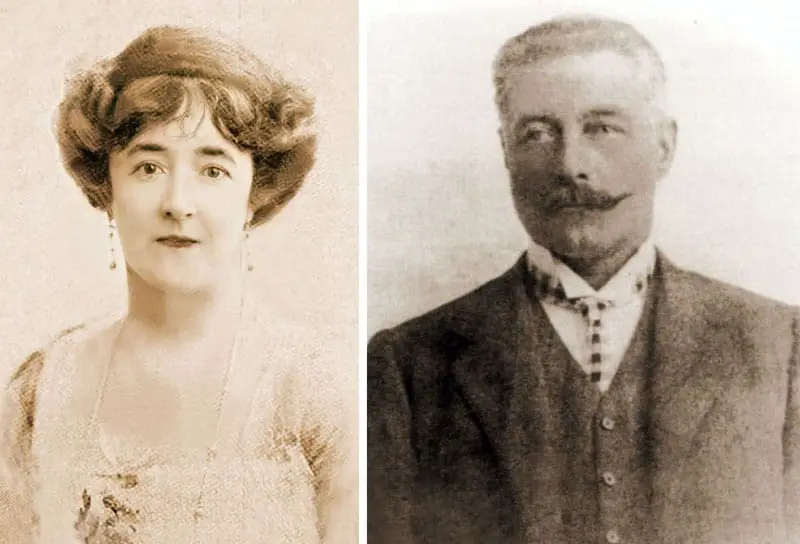
(Randy Bryan Bigham)
May’s memories of that last meal have become classic. For her and many others in the restaurant that night, it was
a brilliant scene. Women beautifully gowned, laughing and talking, the odor of flowers; ridiculous to think of danger… I remember at our table was a great bunch of American Beauty roses. The orchestra played popular music. It was a buoyant, oh so jolly crowd… a rare gathering of beautiful women and splendid men. There was that atmosphere of fellowship and sociability which makes the Sabbath dinner on board ship a delightful occasion…The dinner was the most beautiful I ever saw. We remarked how we might have been in a hotel ashore for all the motion we felt. You had to look out of the portholes to realize that we were at sea. Once we turned and drank toasts to the next table. Not a person at that table was alive the next morning.9
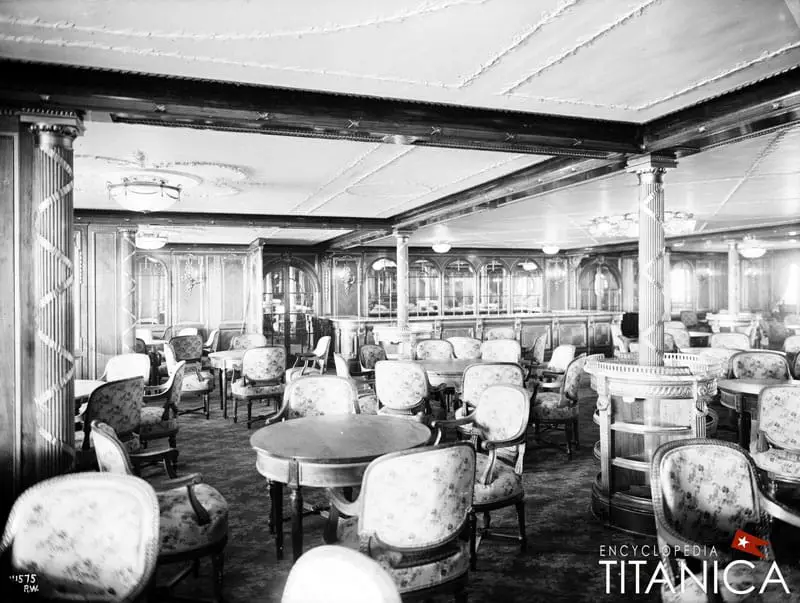
Night of the iceberg
Before turning in that night, May said she and Jack took a short stroll about the deck, probably the Promenade Deck. After walking in the frigid air, she and Jack went into the First Class Lounge to warm up, although many people there kept on their top coats and furs. They may have remained for a time with the Harrises but eventually they parted from their friends, Harry and René going together to the First Class Smoking Room; René even had her own cigarette case.
In the lounge, May decided to look for a book to read from the library shelves:
I went to the library for a book. The books were very dull. I remember John Jacob Astor and his wife came in. They were after a book, too. I finally picked up The Money Moon by Jeffrey Farnol.10
In the lounge at the same time were the Meyers — Leila Saks Meyer, daughter of the founder of Saks Fifth Avenue, and her businessman husband, Edgar. They were in conversation with the Duff Gordons and Miss Francatelli. Also present that night in the lounge was Virginia Clark, an heiress from Los Angeles, talking with Edith Rosenbaum., a New York fashion reporter. Virginia’s husband, Walter, had earlier left to play cards with friends in the smoking room. Artist Philipp Mock and his sister Emma Schabert were also in the lounge that April 14th after dinner wrapped up in the dining saloon and restaurant.

(Randy Bryan Bigham)
Jack got a headache at some point during the evening, necessitating the couple leaving the lounge, although May was all for staying up longer. She begrudgingly left with Jack, helped him into bed in their C Deck room and then climbed into her own bunk to read the book she’d checked out.
Instead of turning out the light, I got a novel and lay reading. Once or twice I nearly fell asleep over it. I had fallen into another sleepy spell when I felt a shock and a kind of shiver of the ship. It was so slight that it did not disturb anything but I sat up in bed.11
May always said her watch read 11:25 but the time was closer to 11:40. Since May later gave so many versions of her Titanic story, it’s unknown which is entirely true, if any — but she and Jack were not out walking on deck as she would later say. It seems Jack was initially awakened by May and urged by her to find out what had happened. Jack merely went to the door of their stateroom at the time, looked out into the foyer and returned to bed, telling May nothing seemed amiss.
Later, they both went into the hall, hearing people running up and down the decks and a gong sounding that indicated nearby watertight doors were shutting. They ran into Harry Harris, poking his head out of his door. He and Jack decided to go upstairs to investigate while May went to the Harrises’ cabin to look after René. She was trying to dress herself with some difficulty owing to her broken arm. They were waiting for the men’s return when a friend of Harry and René’s, John D. Baumann, came to the cabin and waited with them for a while, sharing news he had heard that there had been a collision with an iceberg.
Jack and Harry came back after about 10-20 minutes and explained the situation more thoroughly, insisting there seemed no particular concern.
“We’ve struck an iceberg,” Jack confessed. “It’s alright. Don’t get excited. They are fixing it up and in a little while we’ll proceed.”
“Who told you that?” May insisted.
“You don’t suppose I’d ask the steward do you?” Jack replied. “Captain Smith told me.”12
The Futrelles went back to their cabin to dress more completely, Jack putting on a suit and May wearing a sailor blouse and sports skirt covered with one of her heaviest furs, a seal coat. She also slipped on a pair of mittens and some old high-top shoes that were sturdier than her newer, fashionable ones. While dressing, May heard the ship’s head doctor, Dr. O’ Loughlin, whose office was down the corridor, instructing stewards to tell passengers to put on their lifebelts. When May emerged from her room, she was told by O’ Loughlin she had no time to take anything but herself. Over 6 feet tall, Jack got down lifebelts from above the wardrobe and he and May fastened them on each other.
May recalled having a swig of water from a glass on the dressing table before she left her cabin for good, offering Jack a drink, too. She said she didn’t think until later on about her new pearl necklace, a last gift from Jack in Paris, and neither tried to save any of the four or five book and article manuscripts that they’d been working on.
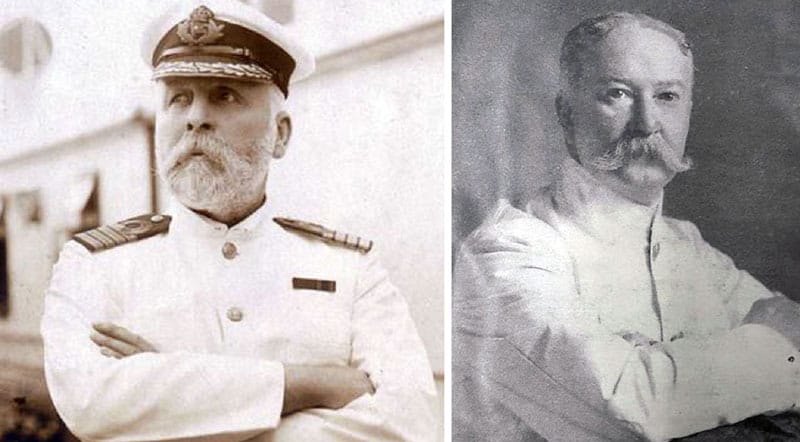
(Randy Bryan Bigham)
They headed topside. If Jack and May were with the Harrises at this point, neither May nor René made that clear. The couples seem to have separated in the crowd as they climbed the aft stairs on their way with other passengers to the lounge on A Deck. As May remembered:
We gathered in the grand saloon, a huge place. We were there a long time, I should say about 20 minutes. There were famous men in that gathering and they all died.13
She saw Benjamin Guggenheim, Frank Millet, Archie Butt, race car driver Washington Roebling, William T Stead, and Charles Hays who assured people that many ships were in the vicinity, in radio contact and that everyone would be rescued if worst came to worst. One woman May recalled in the lounge was a young French beauty who was sobbing; this was likely Ninette Aubart, Guggenheim’s girlfriend, who was there with the maid he’d hired for her, Emma Sagesser.
Morning of the sinking
After hearing the initial summons to the lifeboats, May went up with Jack to the port side of the Boat Deck. There, a second call from the crew, temporarily separating men from women (men on A Deck, women on the Boat Deck), was issued. Plans changed again when Boat 4 was lowered to the level of A Deck for loading passengers at around 12:40 a.m. This soon went awry as it was discovered the promenade windows in that section of the ship were closed and no entry could be made for the time being.
Jack had gone down with May and other people to A Deck, initially hoping to help his wife into No. 4. May was confused as to where she was supposed to be and at first trooped up again to the Boat Deck when some passengers were recalled there. Jack had stayed behind. May was now being corralled into a line to board the next port lifeboat, No. 6, but she became worried for Jack and returned to his side as he stood with Col. Astor on A Deck. May and the others had walked up a crew’s companionway; she now climbed down again.
My husband was giving John Jacob Astor a light for his cigarette. The light showed me his face. They weren’t talking much. The only thing anybody said is that we couldn’t sink.14
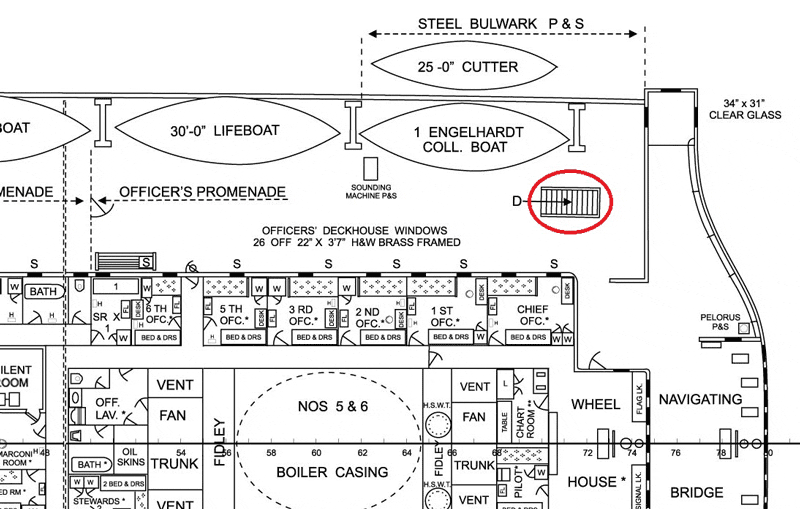
(Encyclopedia-Titanica / Gregg Jasper)
May had returned to the Boat Deck by the time Boat 6 was launched at 12:55 a.m. She remembered Captain Smith and Chief Officer Harry Wilde being there to supervise lowering No. 6 which she believed was the first boat to reach the sea. She later confused this memory, saying Second Officer Charles Lightoller was in charge, so it’s unclear if she meant Boat 6 or No. 8 as both lifeboats were loaded and launched around the same time:
Many people have asked why Captain Smith let that first boat get away with only 24 women in it when it could have taken 65. It has been said he intended putting more people into the boats after they had been lowered to the water’s edge. But I heard him say as the boat was lowered. ‘Row to that steamer, discharge your passengers and come back.’15
May was referring to the lights of a stationary ship on the horizon, believed to be the freighter Californian. Seemingly stopped within 5 miles, it was actually about 13-14 miles away.
Taking the nearby crew’s companionway again, May returned to Jack’s side on A Deck. Once there, she witnessed early preparations for loading Boat 4. The windows weren’t yet open through which passengers would have to pass, but May heard Col. Astor ask the number of the boat so as to locate his wife later. This remembrance later morphed into May claiming she saw the Astors part. Her friend, René Harris, also used this tale to punch up her own story of escape. Neither woman witnessed the Astors’ final goodbye which took place a long time afterwards; by then May had left the ship in a lifeboat and René was on the starboard side of Titanic.
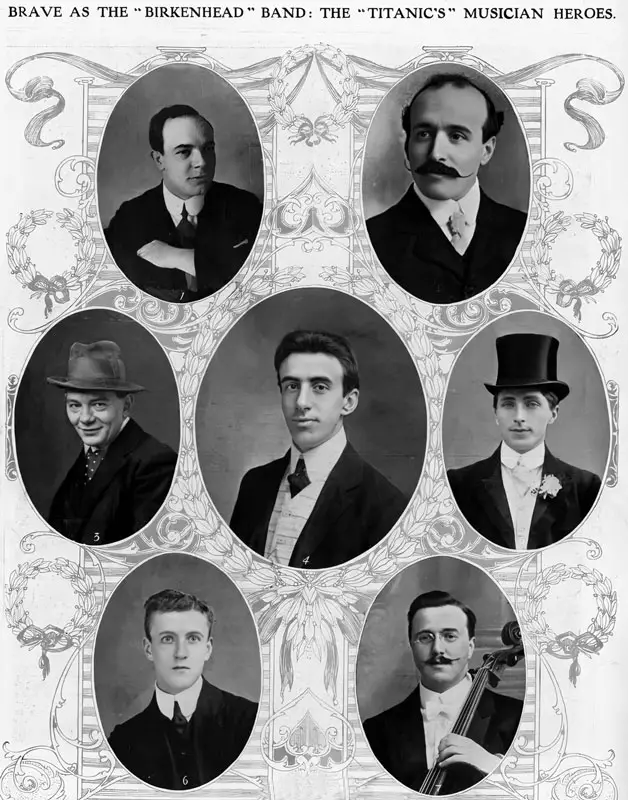
During this period of waiting to get in a lifeboat, and going back and forth from the Boat Deck to be with Jack on A Deck, May remembered the eight-member band playing distinctly. The musicians were on the Boat Deck where there was a piano, she said, but it’s unclear if she meant the band came onto the outer Boat Deck or played inside the entranceway. The song May recalled most among the selections the orchestra played was “Alexander’s Ragtime Band.” She said it was the only piece of popular music they knew which is doubtful.
In some of her articles, May claimed she and Jack walked over at one point to look down at the Forward Well Deck, watching Third Class passengers mill about with their possessions. But in others, she said they went all the way to the stern of the promenade to witness these immigrants. It’s more likely it was the After Well Deck as that scenario jibes with what is known in other accounts that maintain Third Class passengers were massing in large groups at that location by around 1 a.m.
We looked down at the lower decks and saw the steerage passengers. They did not have lifebelts on. My husband said, ‘Those poor devils haven’t a chance’ which indicated he thought we did have a chance.
Jack used the remark to segue to another subject, telling May, “I’m afraid you’re not giving me a chance for my life by staying here. I might save myself in the water, but not you, too.”16
In response, May burst into tears and fled, a knee-jerk decision that would separate her from Jack forever. Hurt and angry at his words, she ran from Jack, rushing through crowds of people on A Deck, hoping to, as she said, find a place to “die somewhere else on the boat.”17 Was it this childish reaction that later caused the trauma that would affect her so deeply, prompting May to spin tales of such magnitude? Was she that angry at herself for letting her frantic state get the best of her?
Although May Futrelle later claimed various circumstances, even that she didn’t run away after all, and that her husband lovingly placed her in a lifeboat himself, it appears she actually did leave him, losing Jack in the throngs on A Deck. Unhappy with him for urging her to get aboard a boat without him, May had emotionally snapped. Suddenly leaving him in such a moment made no sense. Why did she do it?
May’s fit of temperament robbed her of a final goodbye to the man she’d loved for 17 years, the father of her children. Spoiled and haughty, she couldn’t accept Jack’s words of caution and concern and she lashed out at them in a foolish reaction that prevented any calm, sensible leave taking.
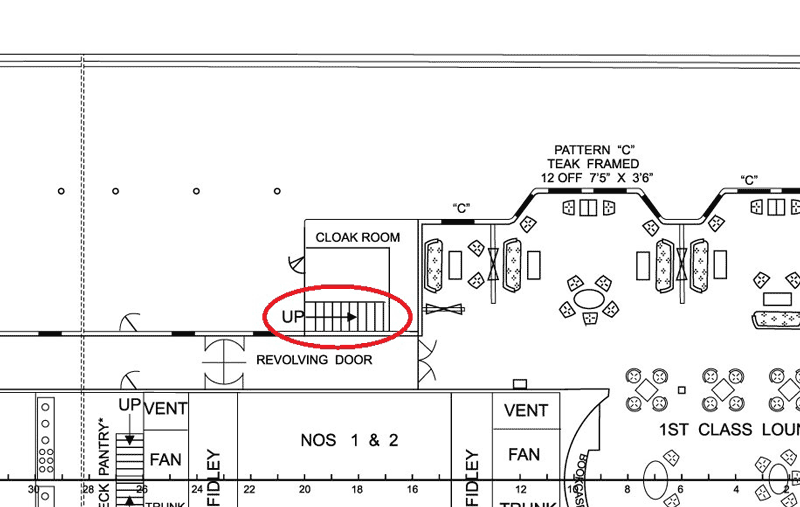
(Encyclopedia-Titanica / Gregg Jasper)
As May rushed down the promenade, heading toward the bow on the port side, Jack following somewhere behind, she was about amidships when out of the crush of people, a ship’s officer emerged, stepping from an iron stairwell that led to the Boat Deck above.
It was Sixth Officer James Moody.
As I started up the companionway, a little chap named Moody, who was lost, said to me, ‘What are you doing below? All the women are gone. Come, hurry.’ He started to pull me up the steps. I said, ‘Don’t pull me!’ Before I could utter a word, he had grabbed me and actually dragged me up the stairs and out onto the boat deck. He took me to the starboard side. ‘There was a boat there a minute ago,’ he said. It was just being lowered.18

(titanicofficers.com)
Tasked by First Officer William Murdoch with rounding up women and children for the lifeboat he was then launching on starboard, No. 9, Moody took May across the deck to where that craft was loading.
The first thing May saw when she gained the starboard Boat Deck was “a group of crewmen with smoke-blackened faces standing silently staring. They said nothing but their eyes seemed to say, ‘At least you have a chance. We have none.’19
May apparently noticed the same group of men that were seen by Edith Rosenbaum on the Boat Deck as she also approached No. 9.
“A number of men were on either side (of me),” recalled Rosenbaum, adding they were “banked up in a solid wall along the side of the ship on the top deck.”20
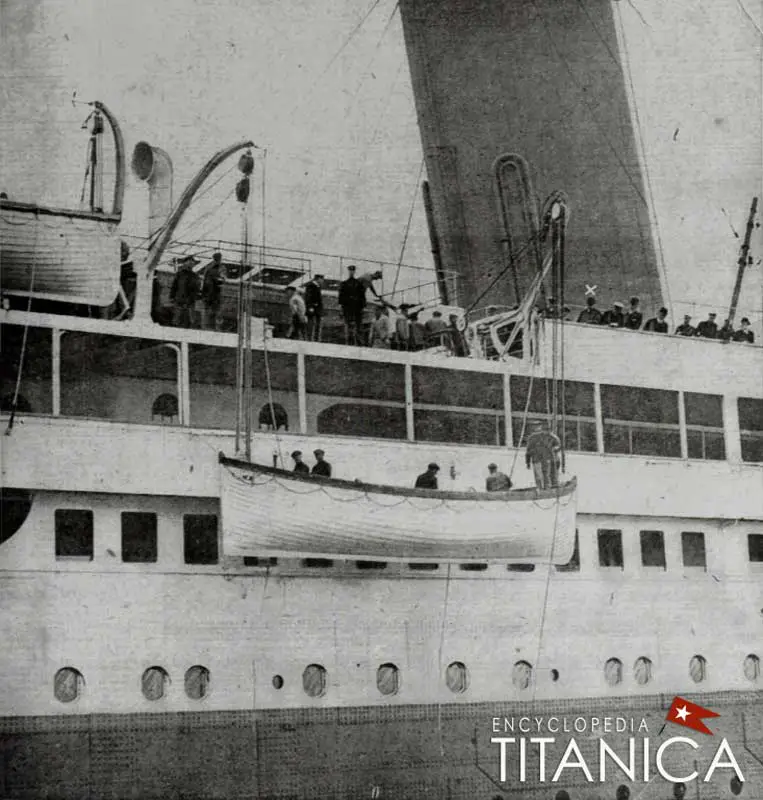
The loading had just finished when May got there; she was tossed in, one of the last to get aboard Boat 9. A meager assortment of occupants were available to go with her in No. 9 as most people were still congregating forward of that location or were filtering over to the port side. A few Second and Third Class men and women arrived from port at the last minute, joining a batch of straggling First Class ladies and a group of stewards and other crewmen.
May recalled a man and his wife trying to get aboard but somehow not managing to get in before No. 9 started lowering on Murdoch’s orders at about 1:15-1:20 a.m. It’s possible this wasn’t a married couple but Philipp Mock and his sister Emma Schabert who remembered approaching Boat 9 until ordered below to board another boat, No. 11, with Edith Rosenbaum.
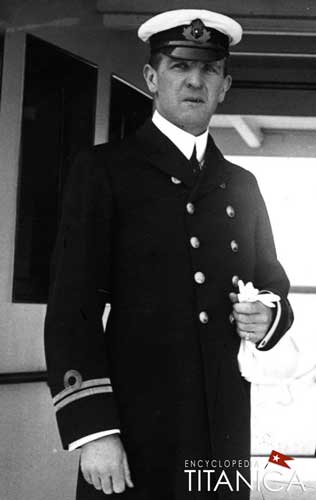
(titanicofficers.com)
May must have regretted not telling Jack goodbye and she might have reflected on her hasty departure as 9 creaked down its falls to the sea, carrying an estimated 40 people. May contended in some accounts that there were but 15 occupants in her boat, in other versions, 30 people, in still others, 63. She was never consistent.
Although May was to say she escaped in Boats 14 and 16 as well as in Collapsible D with René Harris, she was without question in No. 9 which she thought was the last lifeboat. Of all her exaggerations and outright lies, this one might be explainable. By the time May Futrelle came to Boat 9, the other boats near it, Nos 11, 13 and 15, had been lowered to A Deck for loading. She might not have immediately noticed this, hence her impression that 9 was the only boat still hanging in its davits. It was, in fact, the last boat left on the aft starboard Boat Deck.
As for Jack, there’s no indication he realized May got in a lifeboat or ever knew where she’d gone after she ran from him on A Deck. One hopes he eventually guessed she’d gone off in a boat but it’s uncertain whether he did or not.

(Atlanta History Center)
Fast on the heels of her emotional distress, May faced a physical shock when Boat 9 touched down in the water at about 1:25 a.m. Crewmembers were unpracticed at handling the oars and, in distributing them among themselves in an effort to row away as soon as possible, a sailor accidentally knocked May in the head with one. She was stunned by the impact of the heavy wooden blade.
We settled on the water with hardly a splash. Then the men began calling for a knife. The oars were lashed as they had forgotten to cut them loose before they launched. They must have found a knife among them, for a moment later they were shipping the oars. One of the men, in shifting to the other side, dropped his oar blade on my head. I remember thinking, ‘This is the end of me.’21
While dazed, May recovered; still, it’s possible she might have suffered a concussion from the impact of the oar. Coming a few minutes after her frantic separation from Jack, it’s likely her head injury provides a clue to the trauma May underwent.
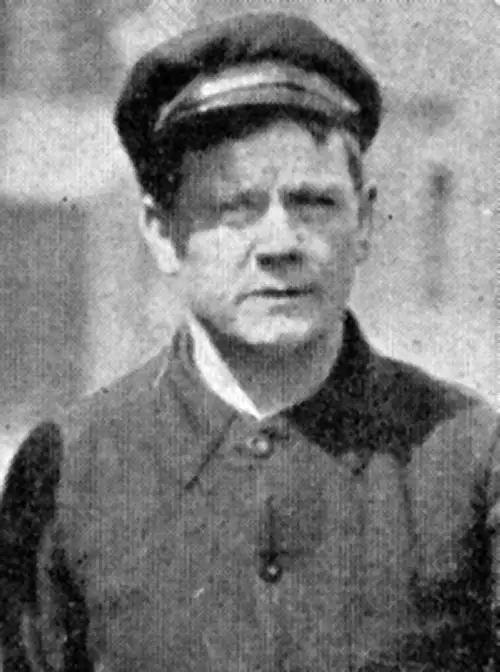
(Cheltenham Looker-On)
May thought there was a boatswain’s mate aboard No. 9, an able-bodied seaman, a smattering of stewards, several Second and Third Class passengers and a few other First Class ladies, among them the crying French woman from the lounge, Mme. Aubart, and a mother with her teenage daughter, Elizabeth and Mary Lines, who were returning to the States to see the family’s son graduate from university.
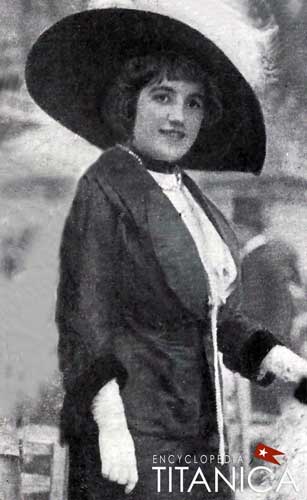
(Randy Bryan Bigham)
May explained later to the Boston Herald:
It was the seaman (George “Paddy” McGough) who saved us, for halfway down, the ropes at the stern of the lifeboat jammed. The bow of it continued to go down and I thought we should all fall into the icy water but the seaman broke the rope with his bare hands and we landed safely on the sea, not in it.22
As Boat 9 paddled slowly, clumsily away from Titanic, May asked McGough, 36, why a steward was aboard if he couldn’t row. He replied, “Madame, he wants to save his life as much as you do yours.”23
First Class Steward Aragóa Drummond Harrison, 40, was one cabin attendant in No. 9 who could row and did. He sat on a thwart beside a First Class lady in a fur who was almost certainly May Futrelle. He was rowing as hard as he could and when he stopped to rest, she took his numbed, swollen fingers and warmed them inside her coat. Harrison noticed the sobbing French lady, too, and that all the other rich women on board wore fur coats.
It was approaching 2 a.m. May said,
I never saw such a quiet, beautiful night. It was dead calm, perfectly clear, brilliant with stars. The surface of the ocean was just heaving gently; there was not a ripple.24
Eventually No. 9 reached a hundred or so yards away and the men rested on their oars. By now, they’d been gone from Titanic for over half an hour. The ship looked less and less likely to recover from its alarming condition, decks dipping noticeably into the ocean, distress flares shooting into an inky sky.
The Titanic still floated, the rows of lights indicating her decks. The rows of lights began to go out by sections, she began to settle by the nose. Then came two dull explosions. We saw her break in two. The bow which had been pointing downward, dipped, turned up again, writhed and sank with the stern.25
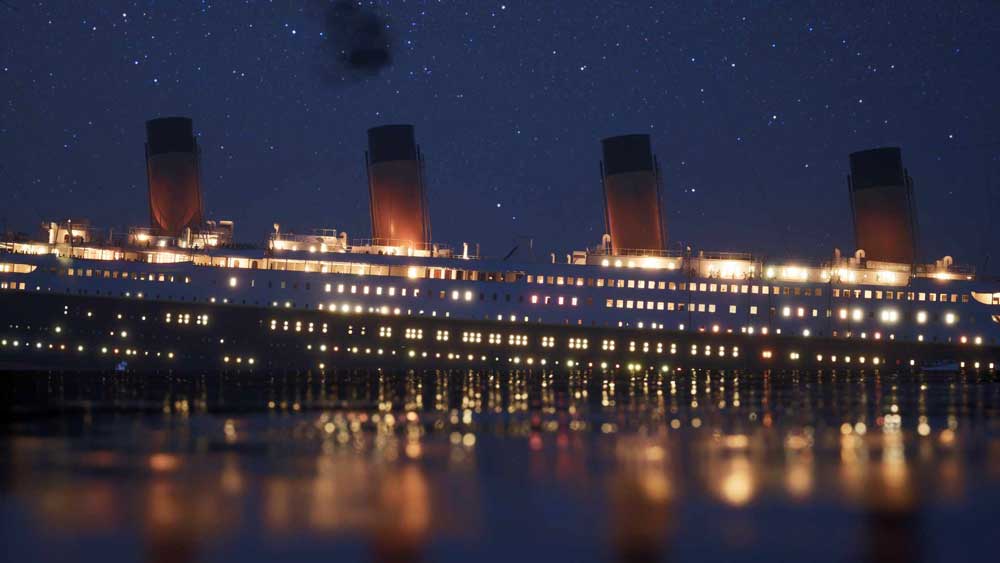
(Titanic: Honor & Glory)
It was then 2:20. The hideous cries in the night from drowning and freezing people came as an ultimate shock to everyone in the lifeboats. True to form, May had an odd response:
As we rowed away, I kept thinking that those on the ship were lucky. They will die quickly but they kept screaming and I remember saying to myself, ‘Haven’t those people died yet? Why do they keep screaming?’26
As usual, May shared conflicting details. The ship broke in two halves, she asserted in 1912, only in later years saying it went down intact. “Nearer My God To Thee” was the dirge played by the orchestra at the last, she claimed; elsewhere she said she never heard it.
All night our boat and the others kept in sight of a boat with a tiny light. One of the ship’s officers had taken off flares and kept one burning. It was four hours later at dawn that the Carpathia picked us up.27
The lifeboat with flares was Boat No. 2, commanded by Fourth Officer Joseph Boxhall. May arrived at Carpathia in what she was told was the fourth boat picked up:
They were very kind to us on the Carpathia. A steward came up to me with a blanket. But I was warmly dressed and told him to save it for someone who needed it.28

(Wikipedia)
May’s anxiety and emotional upset, barring any reasonable thinking, continued aboard the rescue ship. At one point, fellow survivor Eleanor Cassebeer overheard May complaining about money to someone. It happened that Jack had had “$300 in his pockets,” May admitted, so why, she wondered, had he not turned the cash over to her so that she wouldn’t now be penniless? Cassebeer thought it sounded heartless, yet May’s state of mind might still have been compromised after the shock of her tragic decision to run away from Jack at the last moment, coupled with her head injury shortly thereafter.29
May was gradually accepting Jack was no more.
I stood and watched as people came up over the side from the other boats, watching for my husband.30
Jack never came and his body was never recovered. May was such a storyteller, we’ll never know if her concluding comment to the Boston Globe in 1932 about her late husband was true. She told the paper that her husband had always said if he had his wish he would die at sea and be buried there. “It came out just that way,” May said.31
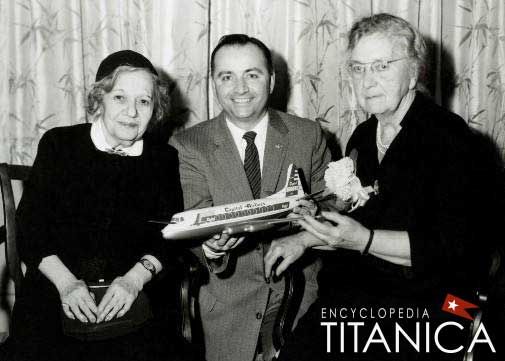
(Wisconsin Historical Society)
Notes
1. Futrelle, Mrs. Jacques (May), “The Last Hours of the Titanic,” New York American, April 28, 1912, p. 6B. Thanks to Gregg Jasper.
2. Boston Herald, November 13, 1955. Thanks to Mike Poirier.
3. Boston Herald, March 15, 1959. Thanks to Mike Poirier
4–6. New York American, April 28, 1912.
7. Liberty, April 23, 1932.
8. Atlanta Constitution, April 26, 1912: May also criticized the Duff Gordons for rumors about their Titanic escape in the same article. She thereafter repeated lies and gossip about the couple in the Philadelphia Inquirer (April 28, 1912) and the Boston Globe (April 17, 1932).
9. Futrelle, Mrs. Jacques (May), “Parting of Wives and Husbands on the Titanic,” St. Louis Post-Dispatch, April 28, 1912, n.p. Futrelle, Mrs. Jacques (May),”Mrs. Jacques Futrelle Tells Story of Wreck of the Titanic,” Philadelphia Inquirer, April 28, 1912, p. 10. Futrelle, Mrs. Jacques (May), “The Story of the Titanic (Part 2),” Philadelphia Inquirer, April 29, 1912, p. 11. Thanks to Gregg Jasper and Mike Poirier.
10. Boston Globe, April 17, 1932. Thanks to Mike Poirier.
11. New York American, April 28, 1912.
12-17. Boston Globe, April 17, 1932.
18. Boston Herald, April 17, 1932, Boston Globe, April 17, 1932. At this stage, the starboard Boat Deck was fairly deserted and Murdoch had enlisted Moody and other crewmembers to bring women and children from port where they were gathering to Boat No. 9. Moody was doing that when he encountered May Futrelle on A Deck.
19. Boston Herald, November 13, 1955.
20. Rosenbaum, Edith, “The Wreck of the Titanic,” Cassell’s Magazine, June 1913, pp. 33-46.
21. New York American, April 28, 1912.
22. Boston Herald, November 13, 1955.
23–25 New York American, April 28, 1912.
26 Boston Herald, November 13, 1955.
27, 28 Boston Globe, April 17, 1932.
29 Walter Lord’s notes from a c. 1964 interview with Eleanor Cassebeer, Lord-McQuitty Archive, National Maritime Museum, London. Thanks to Shelley Binder and Mike Poirier.
30, 31 Boston Globe, April 17, 1932.
Acknowledgements
I’m grateful to Mike Poirier first and foremost for sharing his extensive newspaper files on May Futrelle and also to Gregg Jasper for lending me a copy of May’s 1912 first-hand story for the New York American, one of her more thorough and lucid Titanic accounts. Thanks to Titanic accommodations expert Daniel Klistorner. For images, I’m grateful to Brandon Whited, Philip Hind of Encyclopedia-Titanica, Matt DeWinkeleer of Titanic: Honor & Glory, and Ioannis Georgiou. Finally, thanks to Gregg Jasper, Mike Poirier, George Behe and Samuel Halpern for reading an early draft.

Comment and discuss